A joke I’m told repeatedly by Melbourne residents goes like this – Sydney boasts of having Australia’s best museums, art galleries and restaurants, but there’s a catch –
you have to fly to Melbourne to enjoy them.
The two cities are long-time friendly rivals, and while Sydney has the draw of its harbour, iconic bridge and opera house, Melbourne is experiencing a rebirth and is no longer happy to play second fiddle. It considers itself more sophisticated than Sydney, where dinner-table conversation is typically about property prices. In contrast, Melbourne makes much of its reputation as an art and culture centre.
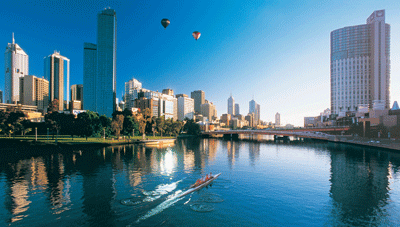
And while Sydney is well known for its high-profile sporting events – the Olympics were a huge success – Australia’s second city arguably trumps them, hosting the Australian Open,the Melbourne Cup, the Australian Grand Prix, major golf tournaments, cricket tests, and rugby finals (a variant called Australian Football League).
The city is home to almost four million of Australia’s 22 million residents and is the capital of Victoria. Melbourne International airport is about 40 minutes’ drive away. The compact downtown area hugs the Yarra River, a once neglected waterway that has been transformed to be a focus of civic pride. The grid street system makes it easy to navigate, and broad sunny avenues clatter with trams, a convenient way to get around. If you are in the city during the summer months, it’s easy to walk to appointments, as many of the top hotels are based in the central business district.
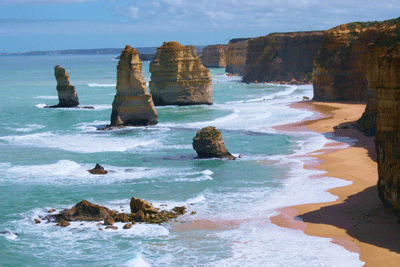
Perhaps the sunshine helps, but Melbourne regularly ranks highly among the world’s most liveable cities, both in terms of quality of life and accessibility of amenities. And in the past 10 years it has really come alive. Downtown is no longer deserted after dark, which is mostly down to the popularity of inner-city apartments – some newly built and others occupying trendy converted warehouses down narrow lanes – but also to new restaurants and 24-hour shops.
David Perry, chief executive and general manager of the Hotel Windsor, one of the city’s most prestigious five-star properties, says: “One of the most attractive features of doing business downtown is that it isn’t a wasteland anymore – many of Melbourne’s top restaurants, both for entertaining and private dining, are in this area.”
It’s around here, too, that there is a buzz of construction and development in spots such as South Wharf, with its recently opened Hilton hotel. Perry says: “The downtown district has been attractively revamped and is one of the main areas for doing business. However, while appointments are likely to be in this neck of the woods, some key companies have their head offices in the up-and-coming Docklands, Southbank and South Melbourne districts.”
The city has Australia’s busiest port, but other major industries include the automotive sector, construction materials, and software development.
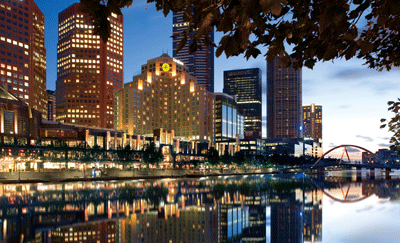
Downtown, banking and finance firms anchor the business district, with some of the country’s biggest pension funds. Half of Australia’s 10 biggest companies have their headquarters in Melbourne, including the two leading Australian banks, ANZ and NAB. Also here is BHP Billiton, Rio Tinto (with joint headquarters in Melbourne and London) and telecoms firm Telstra.
The city’s laid-back approach makes it an enjoyable place to do business. “Formality is minimal,” Perry says. “In fact, the locals will probably use your first name at the first meeting and invite you to do the same. Jackets come off and the mood is immediately casual. But don’t be fooled – they’re serious about business and are determined to get the best deal.”
The global financial crisis seems to have affected Australia less than many other places. Canberra bureaucrats attribute this to fiscal prudence and a canny Reserve Bank, and the signs of recovery in key trading partners, particularly China, are helping. Demand for Australian mineral exports – produced mostly in Western Australia and Queensland – as well as for agricultural commodities have started to increase again. Pre-recession, hoteliers predicted big increases to the city’s relatively low room rates, but this didn’t happen. The recession meant fewer business travellers arrived from overseas – and those that landed demanded deeply discounted rates.
“Overall, we expect a flat year for hotel rates,” Perry says. “The recession ensured room charges won’t move much. Late next year, we expect modest increases.” His opinion is shared by Simon McGrath, vice-president for hotel corporation Accor, Australia, who says “rates will begin to creep up in the latter part of next year”.
One positive sign, says McGrath, is that the conference market, a big one for Melbourne, is recovering and confidence is returning. Perry says: “People are beginning to spend again on travel and entertainment.”
Looking beyond the recession, Victorian premier John Brumby insists that Melbourne remains an attractive destination for investment. Perry believes this is helped by the attitude of Melbourne’s business people. “Decisions come quickly. You’ll know almost immediately whether they are interested,” he says. “They won’t promise to get back to you and leave you hanging on for weeks.”
It’s no surprise, then, that a recent study by multinational commercial real-estate company CB Richard Ellis found Melbourne was poised to overtake Sydney by January 2010 in terms of the amount of prime CBD office space it has, with more than 2,361,000sqm compared with Sydney’s 2,333,000sqm. This will end Sydney’s decade-long rule as Australia’s leading business city. Melbourne skillfully arrested an eastward drift of top companies to Sydney and, in some cases, had relocations reversed.
Kevin Stanley, executive director of global research and consulting in the Pacific region for CB Richard Ellis, says corporations are increasingly declaring that Melbourne would be their base and that they had outgrown Sydney.
Driving this surge in demand is the fact that office rentals – like all rentals – are, on average, 30 percent cheaper than Sydney’s. Researchers estimate Melbourne will have an average 7 percent office-space vacancy rate by December 31, compared with Sydney’s 9 percent.
For frequent business travellers to the city, there is no shortage of entertainment. Festivals of arts, comedy, film, cuisine and theatre create a constant buzz. On the edge of the Southbank is the Arts Centre, home to drama, ballet, opera, orchestral concerts and exhibitions. Clustered in the business district is theatre land, with several grand old venues specialising in mass-appeal stage shows.
Melbourne is made up of adjoining “villages”, or neighbourhoods, where you’ll find some of the best dining and shopping, all within a 10-minute cab ride of downtown. There’s Italianate Lygon Street in Carlton, the Vietnamese-accented Victoria Street in Richmond, or the Spanish-influenced Johnston Street in Fitzroy. Nowhere is a single ethnic flavour dominant – instead, there’s an easy-going and harmonious lack of exclusivity.
On a recent visit I noticed two of Melbourne’s leading restaurants were far busier than on a trip six months ago. One of these – Cantonese eatery Flower Drum (www.flower-drum.com) – is a favourite for business entertaining. The other, Ezard (www.ezard.com.au), has a similarly strong corporate following and is an ideal choice for a meal with shoptalk, as tables are widely spaced, meaning whispers aren’t essential.
As the Hotel Windsor’s Perry says: “Your main reason for being in Melbourne may be business – but it’s pretty difficult not to enjoy the city as well.”
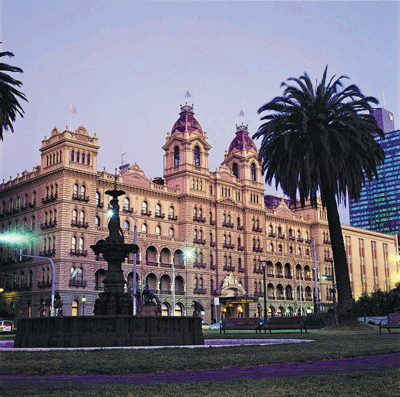
WHAT TO SEE
Want something for nothing? A free City Circle ride supplies splendid orientation and a sampling of Melbourne’s extensive tram network. Taking an hour, the route (clockwise or anti-clockwise) takes in downtown plus Docklands. A recorded commentary highlights landmarks with a dollop of history. Visit www.metlinkmelbourne.com.au
Melbourne is renowned for its lanes – unique in Australia in that the back streets of its former downtown garment and warehouse zone were transformed with hip bars, coffee shops, restaurants, boutiques, hotels, apartments and art galleries. Meriting a browse is Gallery Gabrielle Pizzi (75 Flinders Lane; tel 61 396 542 944; www.gabriellepizzi.com.au), where exhibitions include modern Australian works and Aboriginal paintings.
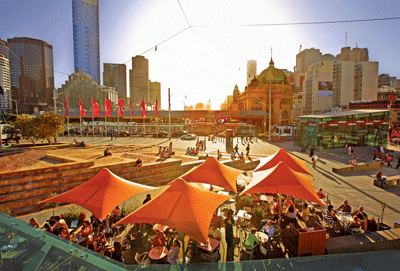
Federation Square, a downtown cultural precinct, remains controversial because critics claim the defiantly modernist buildings situated around cobbled public spaces clash with their traditional backdrop. Among these is the Ian Potter Centre of the National Gallery of Victoria, devoted to Australian and Aboriginal art. (Open 10am-5pm daily, except Monday.) A short walk away is the main building of the National Gallery of Victoria (www.ngv.vic.gov.au) at 180 St Kilda Road, open 10am to 5pm daily, except Tuesday, and focuses on international art.
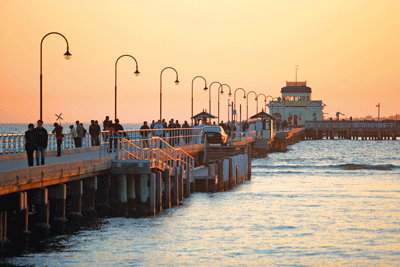
If you have a few spare hours, take a 20-minute tram ride to St Kilda, the city’s top beach, and have a stroll along the pier. Wander down Acland Street, home to numerous restaurants, coffee shops and fashion outlets, and soak in the buzzy atmosphere.
Brunswick Street in Fitzroy is an earthy student zone with eccentric bookshops, funky clothing stores and cheap-and-cheerful restaurants and bars. It mostly attracts locals, while visitors tend to be pointed towards trendier Toorak Road and Chapel Street, or Lygon Street’s “Little Italy”.
Go to www.visitmelbourne.com
WHERE TO STAY
Melbourne is well supplied with global chains and independent hotels in or around downtown. Modest rates include 10 percent goods-and-services tax.
Grand Hotel Melbourne
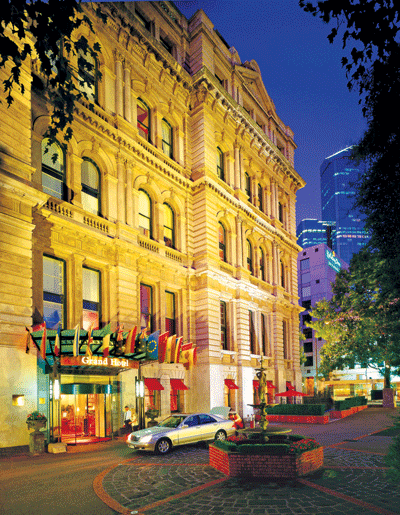
This former railway headquarters is now a 97-room downtown hotel in Accor’s MGallery Collection, and boasts a grand staircase leading to corridors broad enough to accommodate a lorry. Décor in the public areas is Victorian in style but rooms are modern with high ceilings. In-room wired and Wi-Fi internet access is AS$27.50 (US$24) for 24 hours.
Rooms from AS$189 (US$165.5)
33 Spencer Street; tel 61 396 114 567; www.mgallery.com
Crown Metropol Melbourne
Melbourne’s newest hotel offers 658 rooms, including 34 studios and 12 spa accommodations, 32 lofts and one apartment. It boasts two Gordon Ramsay restaurants, the maze and the maze Grill – both are firsts for Australia. A spa is located on the 27th floor a sky bar and terrace on the top floor, level 28.
Rooms from AS$251 (US$219) early bird rate 25 percent off
8 Whiteman Street, Southbank, tel 6139 292 8888
Langham Melbourne
A 387-room five-star on the banks of the Yarra, the Langham is amid Southbank’s lively restaurant and bar precinct. A bridge brings pedestrians to city offices in minutes, and spacious rooms overlook the city skyline. Business amenities include wired and Wi-Fi broadband for AS$25 (US$22) for 24 hours.
Rooms from AS$340 (US$298)
1 Southgate Avenue; tel 61 386 968 888; www.langhamhotels.com
Sofitel Melbourne
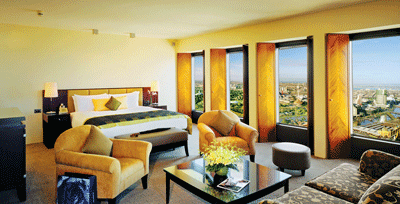
With 363 large rooms above the 35th floor of a centrally located high-rise, the Sofitel has some of Melbourne’s best views. The Atrium bar is popular with business huddles, and in-room wired and Wi-Fi access is AS$27.50 (US$24) for 24 hours.
Rooms from AS$270 (US$236)
25 Collins Street; tel 61 396 530 000; www.sofitel.com
Windsor Melbourne
This 126 year old hotel opposite Parliament House is Melbourne’s grandest – a former Oberoi, it is now independent. Public areas display antiques and artworks, also present in some of the 180 rooms. Wired internet is AS$15 (US$13) for 24 hours. Afternoon tea is a local institution.
Rooms from AS$195 (US$170)
111 Spring Street; tel 61 396 336 000; www.thehotelwindsor.com.au
Hotel Check – Melbourne
The Langham Melbourne
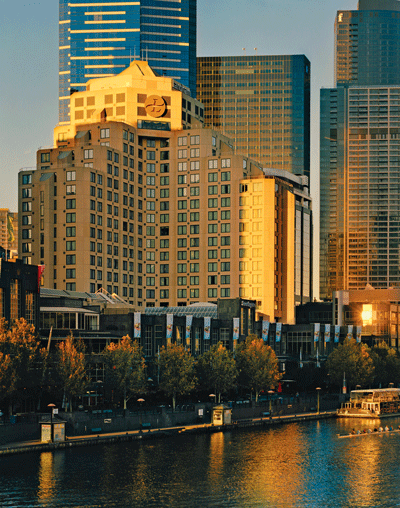
WHAT’S IT LIKE? One of the most sought-after five-star properties in Melbourne, The Langham exudes a distinctly European vibe. The beautiful interiors bear this out with their ambience of timeless sophistication that is matched by impeccable and poised service. But what makes the hotel truly special is its location in the city’s exclusive riverside Southbank precinct, with stunning views of prime landmarks such as Melbourne Aquarium, Federation Square and Eureka Tower Sky Deck. The hotel gives visitors a taste of Melbourne’s opulent inner-city experience.
In 2008, the hotel introduced a new category of frontline staff called “service stylists”. Not tied to a desk or a department, these hotel employees navigate the uncharted territory between concierge, F&B, housekeeping, business centre, front of house, spa, events and guest relations. Knowledgeable in all aspects and offerings within the hotel, service stylists cater to a range of requests from guests in a personal and intuitive yet discreet and efficient manner.
WHERE IS IT? Right at the banks of the iconic Yarra River at a prominent place along the bustling Southbank Promenade that teems with eclectic dining, shopping and entertainment choices. Southbank, which used to be a neglected industrial area, has undergone a successful urban renewal transformation starting in the 1990s with the construction of high-rise apartments and office buildings in the area. For visitors attending meetings and conferences in the city, the Melbourne Convention and Exhibition Centre and the Crown Conference Centre are approximately at 10-minutes’ walk from the hotel.
ROOM FACILITIES: Broadband internet access is available in all guestrooms and suites. A large business desk, marble bathroom with separate shower and bath, well-stocked minibar, in-room safe, tea- and coffee-making facilities, and cable and satellite television channels are all provided.
RESTAURANTS AND BARS: The 225- seater Melba has a series of open, interactive kitchens and cooking stations – Asian wok and dumpling section, the Indian Tandoori oven and spice kitchen, the rotisserie, chilled seafood section, a sushi station and a floating dessert display. The Aria Bar & Lounge on the podium level offers an extensive selection of teas, coffees and light meals throughout the day – the highlight being the signature Langham Tiffin experience on weekdays and the decadent Langham Chocolate Bar on weekends.
BUSINESS AND MEETING FACILITIES: The hotel has 11 venues for meetings and conferences that can host groups between 16 and 400 people. The hotel has a dedicated MICE service called “take the lead”, a one-stop shop that helps meeting planners put together a customised programme that fits their requirements and budget.
LEISURE FACILITIES: Massage treatments at its signature Chuan Spa, a health club featuring a first-rate gym, sauna and steam room facilities, and a rooftop swimming pool.
Gigi Onag
FACT FILE
HOW MANY ROOMS? There are a total of 387 guestrooms measuring between 32sqm and 45sqm, as well as 11 suites and a 177sqm Presidential suite that features stylishly furnished drawing and dining rooms, a second bedroom with a queen-size bed and en-suite bathroom, and a fully equipped kitchen.
ROOM HIGHLIGHTS: Wide windows bring in natural light, giving the room an airy feel. The work area is well-positioned and has a large business desk, which can easily fit a laptop with a lot of space left to accommodate documents.
PRICE: Internet rate for a bed and breakfast package for two people in mid-June starts from A$365 (US$331) a night
in a River View King Room.
CONTACT: One Southgate Avenue, Southbank, Victoria 3006, Australia, tel 613 8696 8888,
VERDICT
Very good. Top-notch facilities with warm friendly service. Its convenient location and easy access to key business and meetings venues make it an ideal base for visiting corporate executives.








